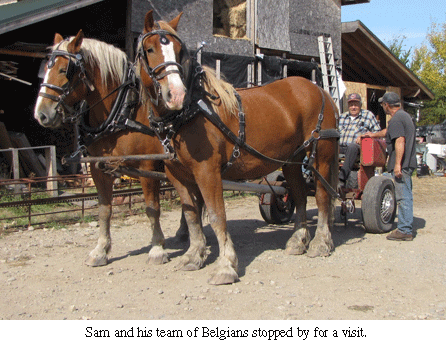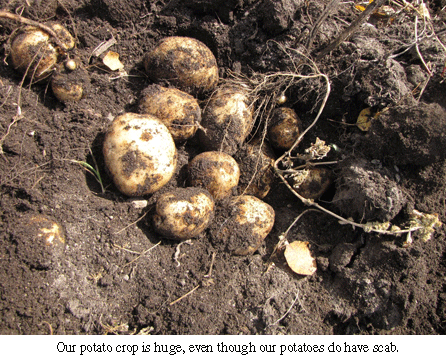The other day our neighbor called to see if we were going to be home. We said “yes,” and he said he’d be over in a few minutes. Well, a few minutes came and went and we wondered where Sam was. I looked out on the driveway and here was a big team of Belgians! Sam had driven a cart over instead of taking his truck. What a nice surprise! I “Belgian-sat” while Will took Sam and Jim, who had ridden over with him, down to show them the progress on the barn.
Today, I’m digging potatoes. We have a nice crop of very large potatoes, but unfortunately, there is some scab on our potatoes again. So next year we’ll have to move the potatoes out of our garden. We tried rotating to new spots, and no luck. So the only out is to move them out of the garden entirely for a few years. Now we’re trying to figure out the best spot for the new potato patch. Unfortunately, there’s no treatment for scab. And, although you can still eat the potatoes, the skin is ugly and baked potatoes are kind of out. Oh well, there’s always some problem to deal with on the homestead; nothing’s perfect.





Hi! Potato Scab is from a fungus. Use elemental sulfur to lower the pH of the soil. Somewhere around 5.5 should work. And wood ashes will raise pH and allow the fungus to grow. Most all soils have the fungus or a relative but need the right conditions to become a problem. And on that note… Jackie, is there someplace in your books about drying potatoes? My wife has all your books, so just a page number would do… I didn’t know if course grating followed by a dunk in lemon juice would work or chipping/slicing them would be better…. Thanks
zelda,
No we burn our potato and tomato vines. No we don’t use manure where our potatoes will be planted. I know about the manure/scab relationship. I buy packaged potato seed. No we didn’t test our water. We will move our potato patch to another spot as this is a proven “cure” unless one of the other factors you’ve noted is present. I’ve seen enough scab during my forty five years of gardening to recognize it well.
Jackie
Jackie, if you are planting Norkota and the seed potatoes are certified, your pH levels low enough, your calcium and phosphorous high enough and your potassium low enough for potatoes, something is really off that maybe moving your potato patch isn’t going to fix. Do you compost your potato plants? and then put that compost back on your potato area? because the bacteria may be coming from the compost. Can you have a soil sample, manure sample (manure is a common source of scab organism) and a scab area cultured by your extension agent (or a talented high school student for a science project)? and have the water you use to irrigate with tested for bacteria? and do you buy local seed potatoes that maybe are being kept in a contaminated place after they are fumigated? Culturing a scab area will tell you whether you really have potato scab (other things look similar). My concern is that without better definition of the potential causes, you may be moving the problem to a new area. Lisa’s use of DE is really interesting because it may be keeping the bacteria from attaching to the skin.
Rather than moving your potato patch every time scab develops, you might try potato towers instead. A potato tower is length of wire fencing made into a cylinder, lined with landscaping fabric, and filled with dirt (and sometimes straw). You simply plant your slips through the landscaping fabric. If your potatoes develop scab, you can simply change out the soil next year. No need to find a different location. Check out the idea here: http://www.instructables.com/id/POTATO-TOWERS/.
I am so sorry that you are having such a problem with your potatoes….such a staple for the table!
The horses are so beautiful. We just had our county fair, and one can only wander to and fro in the stalls, admiring the beauties. Then, to watch them Pull, is a treat in itself. They are amazing. Thanks so much for sharing such a handsome team.
Jon,
You wait until your potato vines have matured and died back. When you dig them, they are usually frosted and dead. We leave our potatoes in the ground as long as we can as they store better in the ground than indoors. But don’t let them freeze or get excessively cold in the ground as they’ll develop black spots and rot in storage.
Jackie
zelda,
Yes we have tested our soil. It is a little acidic, but everything else is fine. Yes, we do plant certified seed potatoes; Norkota Russets, which are quite scab resistant. They still got it. We thought about the potatoes under hay, but decided to move our potato patch instead, so we don’t lose another year with scabby potatoes. I am going to try a small row, just to see.
Jackie
There are growing practices that may control the bacteria that cause it. Have you checked your soil pH? Soil calcium levels? Soil potassiium levels? And if you’ve been re-planting your own potatoes as seed potatoes, unless you treated them with a fungicide first they’ve been carrying the bacteria right back into the soil each year and will carry it into any new potato space you create. It’s a difficult choice that I don’t really like, but even though I grow potatoes in haw or straw I buy fungicide treated seed potatoes each year because once the bacteria gets out of control it is difficult to reclaim the soil. There are also somewhat resistant baking potato varieties. There are a lot of relatively benign and natural soil treatments you can try, but I wonder if you put down a thick layer of your goat hay (not cow or horse manure) and spoiled hay and planted your bakers in that (not touching the soil) if you’d get scab-free potatoes even though the soil is infected. Potatoes grown in hay or straw of course almost never have scab. I know you’ve done it in the past, maybe it’s time to go back to that for a while. I wonder if you put down a heavy black or clear plastic and let the soil cook under it for a season if that would bring the bacteria levels back down. Downside is you’d also cook the earthworms and other soil critters and the populations would have to re-balance over time. Potato scab is such an interesting disease with a huge combination of causes and cures/controls.
How do you know when it is time (or not yet time) to harvest your potatoes>>
Jackie,
We have found that if you cover your potatoes with diatomaceous earth before you plant them in the spring, it will take care of the bugs that make the scab on your harvest of potatoes. We have had great success with this. We also use the d.e. in our hen house to kill mites as well as all over the garden and even around the outside of the house if we are having problems with ants. It is a natural product that is comprised of ground up fossils that is very very fine. It kills insects and pests as they crawl over it by cutting them.
Have a great week! Lisa
I’ve had the scab problem on and off for years. For us it is partly a ph problem as our soil is naturally ph8 and I made the mistake of putting on a lot of wood ashes before I found that out. I had heavy scab on ground that had two years bare fallow. Extension says I may be able to reduce this problem by lowering the ph with elemental sulfur or Aluminum sulfate so we have a soil test out to see how much. Many other vegies will support scab including beets, carrots, and cabbage family. Good luck.
Those are just beautiful Belgians. I love looking at them and would love being around them too. the owners and feeders obviously love them too.
Beautiful team!
Comments are closed.